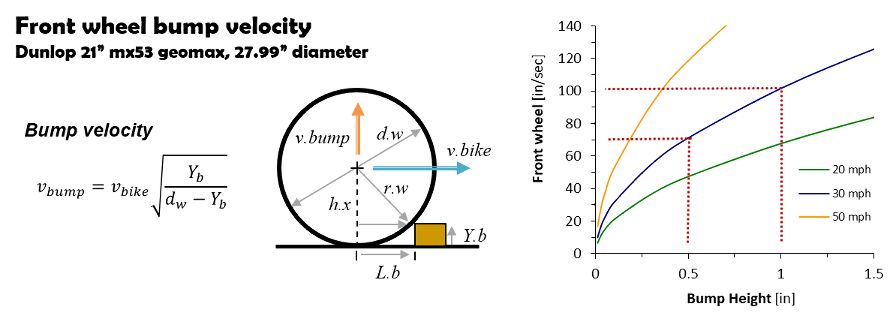One of the most valuable applications of Shim ReStackor is the capability to tune shim stacks to hit specific clicker settings.
Twirling clickers on test rides gives riders the ability to change the suspension “feel”. Tuning shim stacks to hit those specific clicker settings takes the guesswork out of shim stack tuning and sets the damping force in terms of the real world forces you can actually “feel” when you ride.
Based on a test ride, small bump compliance requires the clickers 20 clicks out. But, the 20 click setting makes the bike “feel” sloppy cornering with too much brake dive. To get the bike to handle the clickers need to be ten clicks out.
Fixing the setup requires retuning the base valve shim stack to produce 20 click damping on ½ to one inch bumps and keep the stiffer damping of the current setup at low speed to preserve the bike 10 click handling performance.

Shim ReStackor takes the guesswork out of shim stack tuning to hit specific clicker settings.
Bump velocity
The geometry of a wheel rolling over a bump produces a specific suspension velocity.
Applying the relationship to the diameter of a Dunlop 21” mx53 geomax tire gives a plot of fork bump velocity as a function of bump height and bike speed.
Bump heights of ½ to one inch at 30 mph produce suspension velocities from 70 to 100 inch/sec. The rider wants 20 click damping on that range of bumps.

Suspension bump velocity computed from bump height and bike speed.
Low speed damping
Test ride feedback also shows the rider wants 10 click damping at low speed to get the bike to handle well.
Running Shim ReStackor on the current setup with the clickers set at 10 clicks gives the target low speed damping and rerunning with the clickers set at 20 gives the 70 to 100 in/sec target damping.
To hit the targets the setup needs stiffer low speed damping and softer high speed damping.
- Softer high speed damping requires a softer shim stack
- Stiffer low speed damping requires a preloaded ring shim stack
Adding a ring-shim to preload the stack 0.05 mm gets low speed damping in the ballpark. But, high speed is too soft. Hitting the high speed target requires some stiffer shims in the stack taper.

High speed damping
Using a thicker 0.15 mm shim for the first shim below the clamp increases high speed damping.
The thicker shim moves damping force closer to the 20 click target curve, but more stiffness is needed to hit the target.

Replacing the second shim in the stack taper with a thicker 0.15 mm shim increases the high speed damping and matches the 20 click target curve. The stiffer stack also increases low speed damping, bringing the low speed curve up to match the target 10 click curve.
Tuning damping in terms of clicker settings gives the targeted damping changes you want and avoids testing of endless shim stacks that are way too stiff or way too soft.

Tuning to test ride results
Tuning shim stacks for a +/- 10% change in damping force is straight forward. The more challenging problem is modifying shim stacks to change the shape of the damping force curve with independent control of low and high speed damping.
The capability to fine tune shim stacks to match specific clicker settings sets damping force in terms of the real world forces you can actually “feel” when you ride to relentlessly fine tune the suspension setup.
Shim ReStackor takes the guesswork out of shim stack tuning.

